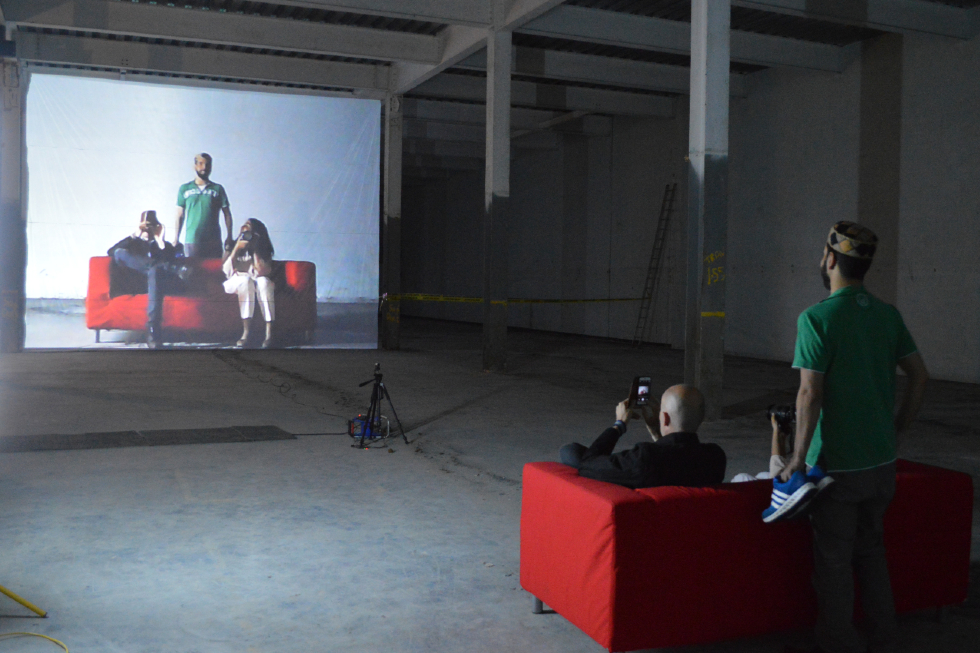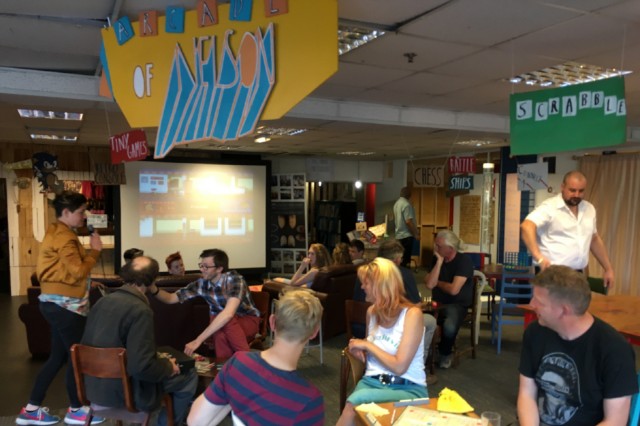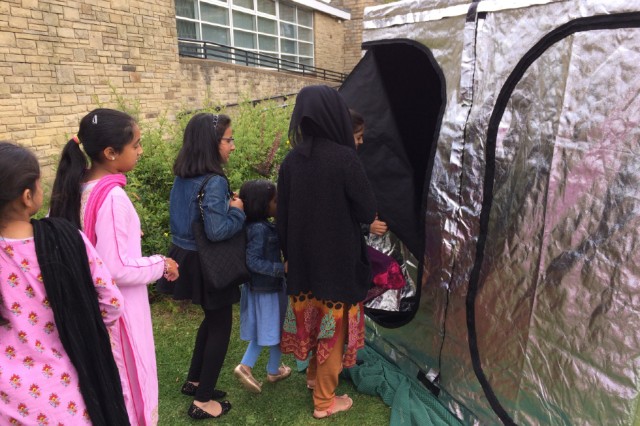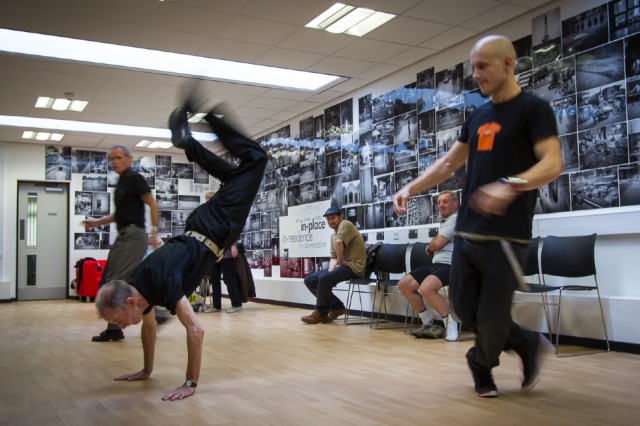Community, Environment and Place – 10 Years of In-Situ

“It is not only In-Situ’s position as a bricks-and-mortar venue in the heart of the community which qualifies it as being embedded.” On the occasion of In-Situ’s 10th anniversary, co-founder William Titley reflects on the organisation’s mission to embed art into everyday life…
Social art practice is often utilised to affect social change through activist and pedagogical processes and In-Situ is no exception in its reciprocal way of working and by being embedded in the life of the area.
With a mission statement making art a part of everyday life, In-Situ applies a code of ethics comprising of a set of key principles and underpins its approach to working with people, place and environment. As an organisation it aims to bring people closer together through a process of social encounters and connections to the place and the community. The work aims to build on the local knowledge of participants. As co-participants everyone involved (including the artist) shares personal stories of contemporary living. From health and wellbeing, financial concerns, joyous tales and tragic circumstances, to exploring what it means to work together through dialogical encounters in meaningful places.
Many social artists who come from a background of formal arts education bring with them an appreciation of, and an alignment with what Japanese philosopher Yuriko Saito refers to as a Western Art Aesthetic. Consequently, these artists must navigate the need to produce some ‘thing’ for dissemination to secondary audiences while simultaneously adhering to processes that are underpinned by a predominantly ethical-social aesthetic.

This alliance with a formal aesthetic together with durational processes generally leads to an output of conventional looking art works, events and activities such as exhibitions of sculpture, painting, performance, creative workshops etc. The artist or organisation achieves this while simultaneously (inadvertently or not) highlighting the presence of another aesthetic, one concerned with their relations with people, place and environment; an aesthetic, which registers actions and/or processes.
In the book Making: Anthropology, Archaeology, Art and Architecture, anthropologist Tim Ingold explored the act of making in the context of the creation of objects and the use of the maker’s materials. His descriptions of engaging with materials and the creative processes involved hold true when transferred to social art practice. He defined two significant approaches to the creative process: morphogenetic, which places “the maker from the outset as a participant in amongst a world of active materials”, and hylomorphic, when a practitioner imposes “forms internal to the mind upon a material world …”.

The social artist who employs a predominantly morphogenetic approach operates in the moment, in the life of the community as it unfolds, and with material whose value emerges through a shared learning process. Whereas the hylomorphic artist applies value to the material beforehand and aims to seek out the resources for a preconceived vision. Both approaches are effective in producing internationally recognised forms of social art and many artists successfully employ a blend of the two.
In his book Conversation Pieces, Grant Kester contrasts a new model for a dialogical aesthetic against the conventional contemporary art aesthetic. He argues that the current contemporary art aesthetic portrays the modern artist as sole creative genius and his new model for a dialogical aesthetic, portrays “… a very different image of the artist, one defined in terms of openness, of listening, and of a willingness to accept a position of dependence and intersubjective vulnerability relative to the viewer or collaborator”.
Kester goes a long way in providing a framework for evaluating the work of social artists, demonstrating that among other things, time, ethics and listening to all forms of communication hold currency in the evaluation of such work.
It is this potentially compromising position of the social artist, somewhere between the two aesthetics of contemporary art and everyday life, which could lead to conflicting ideals around ethical encounters with people and place. For example, take the fine art graduate artist with a portfolio heavily influenced by Anglo-American aesthetics, predominant in UK art school curricula with a focus on the artist working with their chosen materials, be it clay, or paint etc. and usually in isolation. Graduates with such monocular perceptions of aesthetics tend to bring with them a solo creative practice.
Couple this scenario with a growing demand (from funding agencies) for artists to connect directly with communities, and we can imagine a social turn of graduates as they prepare themselves to survive in the real world by tapping into such funding streams. These potential social fine artists can expect direct encounters with people in non-gallery locations, which in turn demands a new set of making skills, together with an ethical underpinning of their creative process, and an awareness of ethical-social aesthetics.
As participants in the social process, they must be ready to spend time getting to know the other material of social art, the other participants, the environment, and the place. As Michael Polanyi points out, “It is not by looking at things but by dwelling in them, that we understand their joint meaning”. The social artist must ultimately be able to empathise with the people, place and environment if they are ever to get close to understanding them; seeing these things in their own context is part of that process of understanding.
It is not only In-Situ’s position as a bricks-and-mortar venue in the heart of the community which qualifies it as being embedded. It is the fact that its very existence owes itself to a dependence on the will of the people, on local cultures and a tacit understanding of the value of growing together with the community in that specific place. Listening to the context of place, together with a process of indwelling helps to locate In-Situ’s activity in, as Kester might say, the “here and now, with local truths … recognising the social context from which others speak, judge and act”.

Ingold also identifies with this symbiotic relationship as “the artisan couples his own movements and gestures – indeed his very life – with the becoming of his materials, joining with and following the forces and flows that bring his work to fruition”, being open enough “to allow knowledge to grow from the inside of being in the unfolding of life”. (Ingold, 2013 p31.p8). In-Situ and the artists working with them are indeed tied together with the community, environment and the place in an unfolding of life.
William Titley is a PhD candidate at Manchester Metropolitan University, and Senior Lecturer/Course Leader for MA Fine Art at The University of Central Lancashire, Preston. One of three co-founders of In-Situ, his artistic research includes curating exhibitions, events, conferences and public interventions and spans over 20 years of social arts practice. He has collaborated with international curators, artists and communities on projects and artworks that interrogate social art practice and reveal collective interpretations of place through durational processes of relational exchange with people, place and environment.
Bibliography: Ingold, T. (2013) Making: anthropology, archaeology, art and architecture by Ingold, Tim., Book. Routledge; Kester, G. H. (2004) Conversation Pieces : Community and Communication in Modern Art. Berkeley and Los Angeles London: University of California Press; Polanyi, M. (2009) The tacit dimension. Chicago, Ill. ; London: The University of Chicago Press; Saito, Y. (2007) Everyday Aesthetics, Everyday Aesthetics.
Based in Pendle, In-Situ’s mission is to embed art in the everyday. Since 2012, it has worked with people and place through art to bring about social and environmental change. This is one of three texts authored by In-Situ’s co-founders.
Images: Zoya Siddiqui In-Residence at Smith and Nephews Mill, Brierfield, 2015; Amy Pennington In-Residence at The SHOP, Nelson, 2016; Ingrid Pollard In-Residence in Brierfield, 2014; SHIFT incl. Recorded Soul at Brierfield Library 2012-15, William Titley





